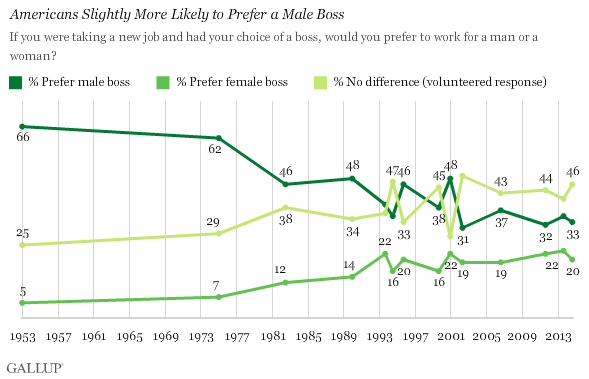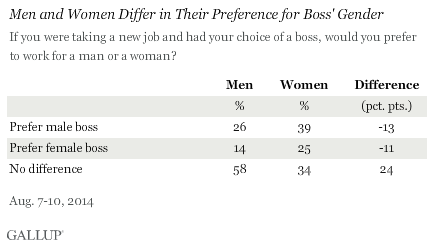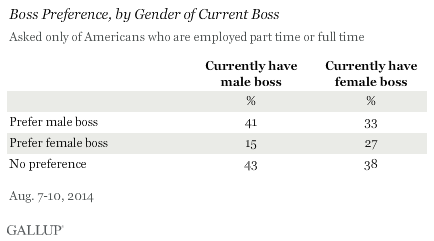This article is featured in "Women and the Workplace," a weeklong series exploring a variety of issues affecting modern working women.
WASHINGTON, D.C. -- Americans are still more likely to say they would prefer a male boss (33%) to a female boss (20%) in a new job, although 46% say it doesn't make a difference to them. While women are more likely than men to say they would prefer a female boss, they are still more likely to say they would prefer a male boss overall.

These results are based on Gallup's annual work and education poll, conducted Aug. 7-10. In 1953, Gallup first asked Americans, "If you were taking a new job and had your choice of a boss, would you prefer to work for a man or a woman?" At that time, 66% of Americans said they preferred a male boss. Five percent said they preferred a female boss, and 25% volunteered that it made no difference.
Women More Likely Than Men to Prefer a Female Boss
In an age when women are told to "lean in" to get positions of power at work, even women are more likely to prefer a male boss to a female boss. However, women have historically been more likely than men to prefer a female boss, although support for preferring a female boss has grown among both groups over time. In 2014, 25% of women say they would prefer a female boss, compared with 14% of men.

The percentage of women who would prefer a female boss has never surpassed 30%. Currently, both genders would prefer a male boss, with 26% of men and 39% of women saying they would prefer a male boss if they were to take a new job. Men are more likely than women to say they have no preference -- 58% mention this response, compared with 34% of women.
The survey indicates that 51% of working Americans currently have a male boss and 33% have a female boss. Those who have a female boss are more likely than those with a male boss to say they would prefer a female boss if they got a new job (27% vs. 15%, respectively).

As Gallup has previously noted, younger Americans are slightly more likely than older Americans to prefer a female boss; however, preference for a male boss is consistent between the two groups. Republicans are more likely to prefer a male boss (42%) to a female boss (16%), while Democrats break even between the two -- 29% prefer male, while 25% prefer female.
Bottom Line
In June, Fortune reported that the number of female CEOs of Fortune 500 companies had reached a historic high, yet only 4.8% of this elite group are women. And while bestselling books like Lean In by Sheryl Sandberg push women to achieve their goals and focus on their careers, Americans' views about wanting female bosses haven't changed since Gallup began asking about them regularly in the 1980s. More Americans continue to prefer a male boss to a female boss -- although, since 2002, the greatest percentage continue to say it does not make a difference to them. While the percentage who prefer a female boss has grown over the last 60 years, it has never passed 25%.
Women, however, are more likely than men to prefer a female boss, even if more women overall still prefer a male boss. Furthermore, workers who currently have a female boss are more likely than those who have a male boss to prefer a female boss in the future. This could mean that as more women enter management, preference for female bosses could continue to rise.
Survey Methods
Results for this Gallup poll are based on telephone interviews conducted Aug. 7-10, 2014, with a random sample of 1,032 adults, aged 18 and older, living in all 50 U.S. states and the District of Columbia.
For results based on the total sample of national adults, the margin of sampling error is ±4 percentage points at the 95% confidence level.
Interviews are conducted with respondents on landline telephones and cellular phones, with interviews conducted in Spanish for respondents who are primarily Spanish-speaking. Each sample of national adults includes a minimum quota of 50% cellphone respondents and 50% landline respondents, with additional minimum quotas by time zone within region. Landline and cellular telephone numbers are selected using random-digit-dial methods. Landline respondents are chosen at random within each household on the basis of which member had the most recent birthday.
Samples are weighted to correct for unequal selection probability, nonresponse, and double coverage of landline and cell users in the two sampling frames. They are also weighted to match the national demographics of gender, age, race, Hispanic ethnicity, education, region, population density, and phone status (cellphone only/landline only/both, and cellphone mostly). Demographic weighting targets are based on the most recent Current Population Survey figures for the aged 18 and older U.S. population. Phone status targets are based on the most recent National Health Interview Survey. Population density targets are based on the most recent U.S. census. All reported margins of sampling error include the computed design effects for weighting.
In addition to sampling error, question wording and practical difficulties in conducting surveys can introduce error or bias into the findings of public opinion polls.
View survey methodology, complete question responses, and trends.
For more details on Gallup's polling methodology, visit www.gallup.com.


